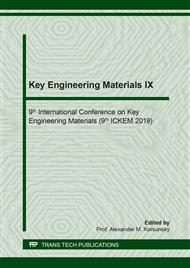[1]
Terrel, Ronald L., and Jon A. Epps. Using additives and modifiers in hot mix asphalt. National Asphalt Association, (1993).
Google Scholar
[2]
Khedaywi, T. S., and S. T. Abu-Orabi. Effect of oil shale ash, rubber ash, husk ash, and polyethylene on properties of asphalt cement., J Petroleum 8, no. 2 (1989): 193-206.
Google Scholar
[3]
Sun, Zhaojie, Junyan Yi, Yudong Huang, Decheng Feng, and Chaoyang Guo. Properties of asphalt binder modified by bio-oil derived from waste cooking oil., Construction and Building Materials 102 (2016): 496-504.
DOI: 10.1016/j.conbuildmat.2015.10.173
Google Scholar
[4]
Chen, Meizhu, Binbin Leng, Shaopeng Wu, and Yang Sang. Physical, chemical and rheological properties of waste edible vegetable oil rejuvenated asphalt binders., Construction and Building materials 66 (2014): 286-298.
DOI: 10.1016/j.conbuildmat.2014.05.033
Google Scholar
[5]
Chen, Meizhu, Feipeng Xiao, Bradley Putman, Bingbing Leng, and Shaopeng Wu. High temperature properties of rejuvenating recovered binder with rejuvenator, waste cooking and cotton seed oils., Construction and Building Materials 59 (2014): 10-16.
DOI: 10.1016/j.conbuildmat.2014.02.032
Google Scholar
[6]
Al-Omari, Aslam A., Taisir S. Khedaywi, and Mohammad A. Khasawneh. Laboratory characterization of asphalt binders modified with waste vegetable oil using SuperPave specifications., International Journal of Pavement Research and Technology 11, no. 1 (2018): 68-76.
DOI: 10.1016/j.ijprt.2017.09.004
Google Scholar
[7]
Dai, Qingli, and Zhanping You. Prediction of creep stiffness of asphalt mixture with micromechanical finite-element and discrete-element models., Journal of Engineering Mechanics133, no. 2 (2007): 163-173.
DOI: 10.1061/(asce)0733-9399(2007)133:2(163)
Google Scholar
[8]
Khasawneh, Mohammad. The Prediction of LWST Values from DFT and CTM Measurements Using Linear and Nonlinear Regression Analyses., Jordan Journal of Civil Engineering 9, no. 4 (2015).
DOI: 10.14525/jjce.9.4.3121
Google Scholar
[9]
Demuth, Howard B., Mark H. Beale, Orlando De Jess, and Martin T. Hagan. Neural network design. Martin Hagan, (2014).
Google Scholar
[10]
Shafabakhsh, G. H., O. Jafari Ani, and M. Talebsafa. Artificial neural network modeling (ANN) for predicting rutting performance of nano-modified hot-mix asphalt mixtures containing steel slag aggregates., Construction and Building Materials 85 (2015): 136-143.
DOI: 10.1016/j.conbuildmat.2015.03.060
Google Scholar
[11]
Xiao, Feipeng, Serji Amirkhanian, and C. Hsein Juang. Prediction of fatigue life of rubberized asphalt concrete mixtures containing reclaimed asphalt pavement using artificial neural networks., Journal of Materials in Civil Engineering 21, no. 6 (2009): 253-261.
DOI: 10.1061/(asce)0899-1561(2009)21:6(253)
Google Scholar
[12]
Xiao, Feipeng, and Serji N. Amirkhanian. Artificial neural network approach to estimating stiffness behavior of rubberized asphalt concrete containing reclaimed asphalt pavement., Journal of Transportation Engineering 135, no. 8 (2009): 580-589.
DOI: 10.1061/(asce)te.1943-5436.0000014
Google Scholar
[13]
Owusu‐Ababio, Sam. Effect of neural network topology on flexible pavement cracking prediction., Computer‐Aided Civil and Infrastructure Engineering 13, no. 5 (1998): 349-355.
DOI: 10.1111/0885-9507.00113
Google Scholar
[14]
Lou, Z., M. Gunaratne, J. J. Lu, and B. Dietrich. Application of neural network model to forecast short-term pavement crack condition: Florida case study., Journal of infrastructure systems 7, no. 4 (2001): 166-171.
DOI: 10.1061/(asce)1076-0342(2001)7:4(166)
Google Scholar
[15]
Gajewski, Jakub, and Tomasz Sadowski. Sensitivity analysis of crack propagation in pavement bituminous layered structures using a hybrid system integrating Artificial Neural Networks and Finite Element Method., Computational Materials Science 82 (2014): 114-117.
DOI: 10.1016/j.commatsci.2013.09.025
Google Scholar
[16]
Yang, Jidong, Jian Lu, Manjriker Gunaratne, and Bruce Dietrich. Modeling crack deterioration of flexible pavements: comparison of recurrent Markov chains and artificial neural networks., Transportation Research Record: Journal of the Transportation Research Board 1974 (2006): 18-25.
DOI: 10.1177/0361198106197400103
Google Scholar
[17]
American Society for Testing and Materials. Standard Test Method for Determining the Flexural Creep Stiffness of Asphalt Binder Using the Bending Beam Rheometer (BBR),, ASMT Standard Test Method D 1298, Book of ASTM Standards, Volume 04.03 (2005), Philadelphia, PA.
DOI: 10.1520/d6648-08r16
Google Scholar


